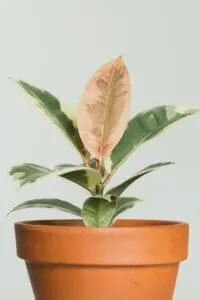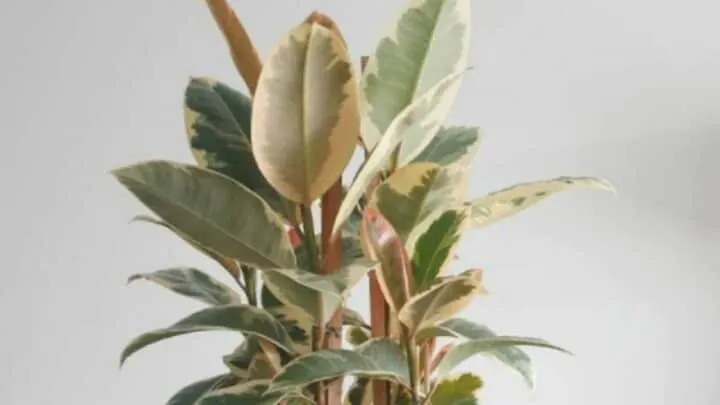Imagine a Rubber plant dressed in an army camouflage uniform.
Yes, that’s precisely what a Ficus Tineke looks like.
The Ficus Tineke is a variegated variety of Ficus Elastica and is growing in popularity exponentially!
Ficus elastica belongs to the Moraceae family according to the University of Arizona.
As if the elegance of a standard Rubber fig was not enough, the highly variegated tri-colored foliage add-on makes it an utterly irresistible house plant.
Ficus Tineke Care
Ficus Tineke needs well-draining and well-aerated soil. It does well in direct or bright indirect sunlight. Deeply water it only when the soil’s completely dry. Ideal growing temperatures are 60-95°F (18-35°C). Provide 50% humidity or more. Fertilize monthly during the growing season using a liquid fertilizer.

Ficus Tineke Care
Table of Contents
Ficus Tineke Care Guide
Soil
Soil requirements for Ficus Tineke are similar to those of regular Ficus Elastica. Ficus Tineke needs well-draining and well-aerated soil. It will tolerate any soil type as long as it drains well. Using a potting mix with organic components is recommended.
Ficus Elastica Tineke will grow well in most types of soils and are not very picky about it.
The only thing these plants ask for is good drainage.
Using only regular garden or potting soil is not recommended because the soil is likely to get compacted and soggy over time, leading to bad drainage and aeration.
It is better to use a combination of materials to prepare a potting mix your Ficus Tineke plant will love.
Garden soil can still be used, but not more than 50% of the potting mix.
Using other media such as houseplant potting mix, peat, or pine bark is recommended along with regular soil.
Using only houseplant potting mix to pot your plant is something that can be done, and your plant would love it. But it can cost you a fortune.
Here is a recipe you can use to prepare the perfect soil mix for Ficus Elastica Tineke.
- Normal soil (1 part)
- Peat (1 part)
- Perlite (1 part)
- Pine bark (1 part)
Using more than one or two potting media to prepare soil mix ensures perfect aeration and drainage.
Organic constituents in the soil act as a slow-release fertilizer, which will keep feeding your Tineke Rubber plant even if you don’t fertilize it.
Light
Ficus Tineke thrives in bright light. It can adapt to direct sunlight as well as bright indirect light. However, in low light, the creamy variegation on the foliage will decrease.
Being a Ficus species, the Ficus Tineke can tolerate a wide range of light levels ranging from direct sunlight to a low-light corner in your room.
If planting outdoors, give your Ficus Tineke a spot where it can get unobstructed sunlight all day round.
The plant can also be grown near a wall or under light shade, but this plant can grow into a big tree.
So, consider the future growth factor of this plant before deciding to give it a permanent home in your garden.
If growing in a pot, this plant will love a place on your patio and will also thrive indoors if given at least 6 hours of bright indirect light every day.
One of the most important considerations when growing this plant in a pot is not to expose it to too much sunlight in the summer months.
The sunlight will slow down growth and the leaves to burn and wilt.
On the contrary, Ficus Tineke will lose its beautiful variegation, and the cream-colored part of the leaves will diminish if not given enough light.
So, to get it right, place your Ficus Tineke near a window that gets adequate sunlight every day.
Even if the sun rays don’t come in, 6 hours of bright indirect light will be enough for your plant to grow well.

Ficus Tineke thrives in bright indirect light
Watering
Ficus Tineke, like all Elastica varieties, requires little water. These plants easily fall prey to root rot, so it’s best to avoid overwatering these plants.
Give it a hearty drink of water only when the soil’s completely dry, preferably the first few inches.
The soaking method is an excellent way to water the plant.
Ficus Elastica, in its natural habitat, grows in hot and humid jungles, where there isn’t much water available. So, they don’t watering a lot and will tolerate underwatering.
The thick and glossy leaves on Ficus Elastica Tineke means it retains a lot of water in its foliage and can go a few days without getting water.
In the growing months of spring and summer, these plants usually require water every week or bi-weekly.
If you live in hotter and drier climates, you can do the watering on alternate days to prevent your plant from wilting.
You will need to drastically alter the watering and schedule and only water these plants once every few weeks in the winter months.
This is because the plant enters dormancy, and the transpiration rates drop to very low levels.
You will not want excess water sitting in the soil for very long in these conditions, so water your variegated Rubber plant sparingly.
Whether you are watering once every few weeks or twice a week, there is one watering practice you can keep the same throughout the year.
That is giving your plant a good drink every time.
Ficus Elastica will perform best when you make sure the whole root ball gets wet when you water.
Water flowing out of the drainage hole is a sign that your plant has had a good drink.
The soaking method is one of the best watering practices to follow with rubber plants. Fill a wide tub of water halfway and place the whole pot inside it.
The dry soil will drink up as much water it requires. Take the pot out of the tub after 4-5 minutes.
The soak method ensures all of the soil and roots of the plant get enough water and saves your plant from other watering-related problems.

Ficus Tineke with its camouflage pattern
Temperature
Ficus Tineke likes it hot. They will grow most rapidly when in places with humid and hot conditions. Ideal growing temperatures are 60-95°F (18-35°C).
You can grow Ficus Tineke as outdoor plants year-round if you’re living in USDA zones 10b-11 according to the University of Florida.
The India-Indonesia native tropical plant thrives in warm conditions.
When you get the plant to grow it at home, you must note that it comes from regions that remain frost-free throughout the year, and temperatures rarely dip below freezing.
Having this knowledge is essential to help a Ficus Elastica Tineke thrive in your possession.
This will help you understand whether or not you can grow a variegated Rubber fig outdoors or not in the sort of climate you live in.
This plant will not grow in temperatures lower than 50°F (10°C). When the winter comes, the tropical houseplant goes into dormancy.
Humidity
Ficus Tineke loves high humidity conditions. A minimum of 40-50% humidity needs to be maintained for the plant to grow well.
When growing indoors, humidity can be maintained with a humidifier or humidity tray.
This plant is native to regions where it stays humid to some extent at all times.
The best way to help any plant thrive is to replicate its native growing conditions as closely as possible.
Avoid placing your Variegated Rubber plant in drafty places, for instance, under fans, air vents, or open windows in the winter.
To notch up the humidity, you can use a humidifier. Using a humidity tray is also a cheap but fantastic alternative.
Use a shallow tray and place your Ficus Tineke pot in it. Fill the tray halfway with water, and then add pebbles to fill the space.
The pebbles, along with the water, will create excellent humidity around the plant.

A minimum of 40% humidity is needed for Ficus Tineke
Fertilizer
Fertilization is not entirely necessary for Ficus Tineke. But you can feed it with monthly doses of mild liquid fertilizer to encourage vigorous and healthy foliage.
The Variegated variety of the Rubber plant is a light feeder. But every plant needs some nutrition to sustain healthy growth.
When growing this plant in a container, it is a good idea to fertilize the soil once every month or two.
Fertilization is ever more needed when the potting mix is not very rich in organic matter.
You can feed the plant with organic compost for outdoor plants or a water-soluble blend for houseplants.
Make sure to add the fertilizer far from the trunk and in moderation.
Growth
Rubber plant Tineke can grow into a 50-feet tall giant tree when grown in the ground. In pots, the plant will usually grow 4-5 times the length of the pot before the root system is unable to counter the height. Growth is most vigorous in humid conditions.
Ficus Tineke has large thick, glossy leaves that can be 12 inches long and 5 inches wide. This variety features an attractive tri-color pattern.
With deep green in the middle, light green before the leaf border, and pale cream right at the edges, the foliage of this remarkable variety is something to drool over.
Variegation means the plant has less chlorophyll and will grow at a slower rate than the standard Ficus Elastica.

Rubber plants can grow up to 50-feet tall
Potting
The Variegated Rubber plant needs a pot with good drainage.
Use a big pot if you want your plant to grow into a bushy tree. Clay pots are recommended over others due to soil aeration purposes.
Choosing the right pot can mean all the difference between a healthy and vigorous Ficus Tineke and a sad one.
The bigger the pot you choose, the bigger the root system it can sustain.
A smaller pot will limit root growth and slow down plant growth drastically.
Pruning
Ficus Elastica will not need to be pruned as a houseplant as it won’t grow so big.
You’ll only need pruning when you grow the plant in a medium-large-sized tree. You can easily prune it to shape, but be careful with the leaking white sap, which may cause skin irritation.
With its slow-growing pace, you will not need to prune a Ficus Tineke, at least not before it is a few years old.
In a pot, its growth is already slow so pruning the precious foliage is a waste.
When it grows big, you can prune it off to shape at any time of the year.
Ficus Tineke Propagation

Ficus Tineke can be propagated using stem cuttings or air layering
Ficus Tineke can easily be propagated during the spring or summer months through cuttings or air layering.
Cuttings can be planted in soil or water. Thicker stems can be propagated by air layering.
Take hardwood cuttings from the plant using sharp and clean pruners. Make a slanting cut to separate the cutting.
Place the cuttings in clean drinking water, making sure you place them somewhere warm and bright.
The cuttings will root within 6 weeks. Alternatively, plant the cuttings in moist potting media and cover them with a clear plastic bag for water retention.
View this post on Instagram
Frequently Asked Questions about Ficus Tineke Care
How to increase variegation in Ficus Tineke?
The two main triggers of variegation in a plant are intense light and cool temperatures. Although the pair is tough to manage simultaneously, you can create such an environment artificially by placing your Ficus Tineke in bright light but also a cool room.
Does Ficus Tineke have aerial roots?
Ficus Tineke typically produces aerial roots in high humidity conditions. However, the Tineke variety is a bit less likely to produce a lot of aerial root growth. This plant may grow a few aerial roots when kept in very high humidity and rocks placed around the trunk.
Conclusion About Ficus Tineke
Ficus Tineke is a unique plant that is surely a treat to grow.
Caring for this plant is as easy as it gets and the reward for good care is even greater in the form of unique variegated foliage.
Grow it indoors or outdoors. This plant will seldom ask for special attention and will grow on its own.

Daniel has been a plant enthusiast for over 20 years. He owns hundreds of houseplants and prepares for the chili growing seasons yearly with great anticipation. His favorite plants are plant species in the Araceae family, such as Monstera, Philodendron, and Anthurium. He also loves gardening and is growing hot peppers, tomatoes, and many more vegetables.


